Byzantine music
| Music of Greece | |
|---|---|
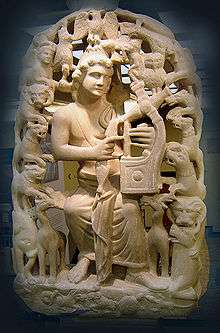 | |
| General topics | |
| Genres | |
| Specific forms | |
| Media and performance | |
| Music awards |
|
| Music charts | |
| Music festivals | |
| Music media |
|
| Nationalistic and patriotic songs | |
| National anthem | "Hymn to Liberty" |
| Regional music | |
| Related areas | Cyprus, Pontus, Constantinople, South Italy |
| Regional styles |
|
Byzantine music is the music of the Byzantine Empire. Originally it consisted of songs and hymns composed to Greek texts used for courtly ceremonials, during festivals, or as paraliturgical and liturgical music. The ecclesiastical forms of Byzantine music are the best known forms today, because different Orthodox traditions still identify with the heritage of Byzantine music, when their cantors sing monodic chant out of the traditional chant books such as sticherarion, which in fact consisted of five books, and the heirmologion. Byzantine music did not disappear after the fall of Constantinople. Its traditions continued under the Patriarchate of Constantinople, which was annexed by the Islamic Ottoman ruler Sultan Mehmed II in 1453, and granted administrative responsibilities over all Orthodox Christians. During the decline of the Ottoman Empire in the 19th century, burgeoning splinter nations in the Balkans declared autonomy or "autocephaly" against the Ecumenical Patriarchate. The new self-declared patriarchates were independent nations defined by their religion. In this context, Christian religious chant practiced in the Ottoman empire, Bulgaria, Serbia and Greece among other nations, was based on the historical roots of the art tracing back to the Byzantine Empire, while the music of the Patriarchate created during the Ottoman period was often regarded as "post-Byzantine". This explains why Byzantine music refers to several Orthodox Christian chant traditions of the Mediterranean and of the Caucasus practiced in recent history and even today, and this article cannot be limited to the music culture of the Byzantine past.
Imperial Age
| Byzantine culture |
|---|
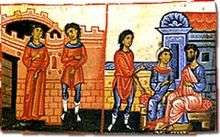 |
The tradition of eastern liturgical chant, encompassing the Greek-speaking world, developed in the Byzantine Empire from the establishment of its capital, Constantinople, in 330 until its fall in 1453. It is undeniably of composite origin, drawing on the artistic and technical productions of the classical Greek age and inspired by the monophonic vocal music that evolved in the early Greek Christian cities of Alexandria, Antioch and Ephesus.[1] It was imitated by musicians of the 7th century to create Arab music as a synthesis of Byzantine and Persian music, and these exchanges were continued through the Ottoman Empire until Istanbul today.[2]
The term Byzantine music is sometimes associated with the medieval sacred chant of Christian Churches following the Constantinopolitan Rite. There is also an identification of "Byzantine music" with "Eastern Christian liturgical chant", which is due to certain monastic reforms, such as the Octoechos reform of the Quinisext Council (692) and the later reforms of the Stoudios Monastery under its abbots Sabas and Theodore.[3] The triodion created during the reform of Theodore was also soon translated into Slavonic, which required also the adaption of melodic models to the prosody of the language. Later, after the Patriarchate and Court had returned to Constantinople in 1261, the former cathedral rite was not continued, but replaced by a mixed rite, which used the Byzantine Round notation to integrate the former notations of the former chant books (Papadike). This notation had developed within the book sticherarion created by the Stoudios Monastery, but it was used for the books of the cathedral rites written in a period after the fourth crusade, when the cathedral rite was already abandoned at Constantinople. It is being discussed that in the Narthex of the Hagia Sophia an organ was placed for use in processions of the Emperor’s entourage.[4]
The earliest sources and the tonal system of Byzantine music
According to the chant manual "Hagiopolites", the earliest that has survived until today, chanters of the Hagia Sophia used a system 16 church tones (echoi), while the author of this treatise introduces to a tonal system of 10 echoi. Nevertheless, both schools have in common a set of 4 octaves (protos, devteros, tritos, and tetartos), each of them had a kyrios echos (authentic mode) with the finalis on the degree V of the mode, and a plagios echos (plagal mode) with the final note on the degree I. The resulting eight modes (octoechos) had been identified with the seven tropes (tropoi) of the Ancient Greek harmonikai, the Pythagorean mathematic discipline of music theory as it had been formulated by the harmonikoi during the Hellenic period. Today, chanters of the Christian Orthodox churches identify with the heritage of Byzantine music whose earliest composers are remembered by name since the 5th century, with compositions related to them, although it is nearly impossible to reconstruct the original melodies of their hymnodic poems. The melodic neume notation of Byzantine music developed late since the 10th century, with the exception of an earlier ekphonetic notation, interpunction signs used in lectionaries, but modal signatures for the eight echoi can already be found in fragments (papyri) of monastic hymn books (tropologia) dating back to the 6th century.[5]
Despite the censorship marking the rise of Christian civilization within Hellenism, certain concepts of knowledge and education did still survive during the imperial age, when Christianity became the official religion.[6] The Pythagorean sect and music as part of the four "cyclical exercises" (ἐγκύκλια μαθήματα) that preceded the Latin quadrivium and science today based on mathematics, established mainly among Greeks in southern Italy (at Taranto and Crotone). Greek anachoretes of the early Middle Ages did still follow this education. The Calabrian Cassiodorus founded Vivarium where he translated Greek texts (science, theology and the Bible), and John of Damascus who learnt Greek from a Calabrian monk Kosmas, a slave in the household of his privileged father at Damascus, mentioned mathematics as part of the speculative philosophy.[7]
| “ | Διαιρεῖται δὲ ἡ φιλοσοφία εἰς θεωρητικὸν καὶ πρακτικόν, τὸ θεωρητικὸν εἰς θεολογικόν, φυσικόν, μαθηματικόν, τὸ δὲ πρακτικὸν εἰς ἠθικόν, οἰκονομικόν, πολιτικόν.[8] | ” |
According to him philosophy was divided into theory (theology, physiology, mathematics) and practice (ethics, economy, politics), and the Pythagorean heritage was part of the former, while only the ethic effects of music were relevant in practice. The mathematic science harmonics was usually not mixed with the concrete topics of a chant manual.
Nevertheless, Byzantine music is modal and entirely dependent on the Ancient Greek concept of harmonics.[9] Its tonal system is based on a synthesis with ancient Greek models, but we have no sources left that explain to us how this synthesis was done. Carolingian cantors could mix the science of harmonics with a discussion of church tones, named after the ethnic names of the octave species and their transposition tropes, because they invented their own octoechos on the basis of the Byzantine one. But they made no use of earlier Pythagorean concepts that had been fundamental for Byzantine music, including:
| Greek Reception | Latin Reception |
|---|---|
| the division of the tetrachord by three different intervals | the division by two different intervals (twice a tone and one half tone) |
| the temporary change of the genus (μεταβολὴ κατὰ γένος) | the official exclusion of the enharmonic and chromatic genus, although its use was rarely commented in a polemic way |
| the temporary change of the echos (μεταβολὴ κατὰ ἤχον) | a definitive classification according to one church tone |
| the temporary transposition (μεταβολὴ κατὰ τόνον) | absonia (Musica and Scolica enchiriadis, Berno of Reichenau, Frutolf of Michelsberg), although it was known since Boethius' wing diagramme |
| the temporary change of the tone system (μεταβολὴ κατὰ σύστημα) | no alternative tone system, except the explanation of absonia |
| the use of at least three tone systems (triphonia, tetraphonia, heptaphonia) | the use of the systema teleion (heptaphonia), relevance of Dasia system (tetraphonia) outside polyphony and of the triphonia mentioned in the Cassiodorus quotation (Aurelian) unclear |
| the microtonal attraction of mobile degrees (κινούμενοι) by fixed degrees (ἑστώτες) of the mode (echos) and its melos, not of the tone system | the use of dieses (attracted are E, a, and b natural within a half tone), since Boethius until Guido of Arezzo's concept of mi |
It is not evident by the sources, when exactly the position of the minor or half tone moved between the devteros and tritos. It seems that the fixed degrees (hestotes) became part of a new concept of the echos as melodic mode (not simply octave species), after the echoi had been called by the ethnic names of the tropes.
Instruments within the Byzantine Empire
The 9th century Persian geographer Ibn Khurradadhbih (d. 911); in his lexicographical discussion of instruments cited the lyra (lūrā) as the typical instrument of the Byzantines along with the urghun (organ), shilyani (probably a type of harp or lyre) and the salandj (probably a bagpipe).[11]
The first of these, the early bowed stringed instrument known as the Byzantine lyra, would come to be called the lira da braccio,[12] in Venice, where it is considered by many to have been the predecessor of the contemporary violin, which later flourished there.[13] The bowed "lyra" is still played in former Byzantine regions, where it is known as the Politiki lyra (lit. "lyra of the City" i.e. Constantinople) in Greece, the Calabrian lira in Southern Italy, and the Lijerica in Dalmatia.
The second instrument, the organ, originated in the Hellenistic world (see Hydraulis) and was used in the Hippodrome in Constantinople during races.[14][15] A pipe organ with "great leaden pipes" was sent by the emperor Constantine V to Pepin the Short King of the Franks in 757. Pepin's son Charlemagne requested a similar organ for his chapel in Aachen in 812, beginning its establishment in Western church music.[15]
The final Byzantine instrument, the aulos, was a double-reeded woodwind like the modern oboe or Armenian duduk. Other forms include the plagiaulos (πλαγίαυλος, from πλάγιος, plagios "sideways"), which resembled the flute,[16] and the askaulos (ἀσκαυλός from ἀσκός askos "wine-skin"), a bagpipe.[17] These bagpipes, also known as Dankiyo (from ancient Greek: angion (Τὸ ἀγγεῖον) "the container"), had been played even in Roman times. Dio Chrysostom wrote in the 1st century of a contemporary sovereign (possibly Nero) who could play a pipe (tibia, Roman reedpipes similar to Greek aulos) with his mouth as well as by tucking a bladder beneath his armpit.[18] The bagpipes continued to be played throughout the empire's former realms down to the present. (See Balkan Gaida, Greek Tsampouna, Pontic Tulum, Cretan Askomandoura, Armenian Parkapzuk, and Romanian Cimpoi.)
Acclamations at the court and the ceremonial book
Secular music existed and accompanied every aspect of life in the empire, including dramatic productions, pantomime, ballets, banquets, political and pagan festivals, Olympic games, and all ceremonies of the imperial court. It was, however, regarded with contempt, and was frequently denounced as profane and lascivious by some Church Fathers.[19]
Another genre that lies between liturgical chant and court ceremonial are the so-called polychronia (πολυχρονία) and acclamations (ἀκτολογία).[20] The acclamations were sung to announce the entrance of the Emperor during representative receptions at the court, the hippodrome or in the cathedral. They can be distinct from the polychronia, ritual prayers or ektenies for present political rulers and are usually answered by a choir with formulas such as "Lord protect" (κύριε σῶσον) or "Lord have mercy on us/them" (κύριε ἐλέησον).[21] The documented polychronia in books of the cathedral rite allow a geographical and a chronological classification of the manuscript and they are still used during ektenies of the divine liturgies of national Orthodox ceremonies today. The hippodrome was used for a traditional feast called Lupercalia (15 February), and on this occasion the following polychronion was celebrated:[22]
| Claqueurs: | Lord, protect the Master of the Romans. | Οἱ κράκται· | Κύριε, σῶσον τοὺς δεσπότας τῶν Ῥωμαίων. |
| The people: | Lord, protect (X3). | ὁ λαός ἐκ γ'· | Κύριε, σῶσον. |
| Claqueurs: | Lord, protect to whom they gave the crown. | Οἱ κράκται· | Κύριε, σῶσον τοὺς ἐκ σοῦ ἐστεμμένους. |
| The people: | Lord, protect (X3). | ὁ λαός ἐκ γ'· | Κύριε, σῶσον. |
| Claqueurs: | Lord, protect the Orthodox power. | Οἱ κράκται· | Κύριε, σῶσον ὀρθόδοξον κράτος· |
| The people: | Lord, protect (X3). | ὁ λαός ἐκ γ'· | Κύριε, σῶσον. |
| Claqueurs: | Lord, protect the renewal of the annual cycles. | Οἱ κράκται· | Κύριε, σῶσον τὴν ἀνακαίνησιν τῶν αἰτησίων. |
| The people: | Lord, protect (X3). | ὁ λαός ἐκ γ'· | Κύριε, σῶσον. |
| Claqueurs: | Lord, protect the wealth of the subjects. | Οἱ κράκται· | Κύριε, σῶσον τὸν πλοῦτον τῶν ὑπηκόων· |
| The people: | Lord, protect (X3). | ὁ λαός ἐκ γ'· | Κύριε, σῶσον. |
| Claqueurs: | May the Creator and Master of all things make long your years with the Augustae and the Porphyrogeniti. | Οἱ κράκται· | Ἀλλ᾽ ὁ πάντων Ποιητὴς καὶ Δεσπότης τοὺς χρόνους ὑμῶν πληθύνει σὺν ταῖς αὐγούσταις καὶ τοῖς πορφυρογεννήτοις. |
| The people: | Lord, protect (X3). | ὁ λαός ἐκ γ'· | Κύριε, σῶσον. |
| Claqueurs: | Listen, God, to your people. | Οἱ κράκται· | Εἰσακούσει ὁ Θεὸς τοῦ λαοῦ ἡμῶν· |
| The people: | Lord, protect (X3). | ὁ λαός ἐκ γ'· | Κύριε, σῶσον. |
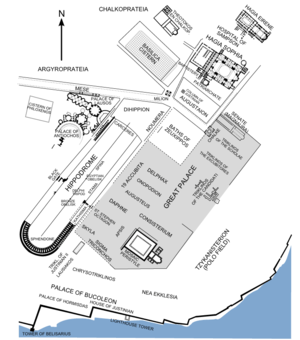
The main source about court ceremonies is an incomplete compilation in a 10th-century manuscript that organised parts of a treatise Περὶ τῆς Βασιλείου Τάξεως ("On imperial ceremonies") ascribed to Emperor Constantine VII, but in fact compiled by different authors who contributed with additional ceremonies of their period.[23] In its incomplete form chapter 1–37 of book I describe processions and ceremonies on religious festivals (many lesser ones, but especially great feasts such as the Elevation of the Cross, Christmas, Epiphany, Palm Sunday, Good Friday, Easter and Ascension Day and saint's days including St Demetrius, St Basil etc. often extended over many days), while chapter 38–83 describe secular ceremonies or rites of passage such as coronations, weddings, births, funerals, or the celebration of war triumphs.[24] For the celebration of Epiphany the protocol begins to mention several stichera and their echoi (ch. 3) and who had to sing them:
| “ | Δοχὴ πρώτη, τῶν Βενέτων, φωνὴ ἢχ. πλαγ. δ`. « Σήμερον ὁ συντρίψας ἐν ὕδασι τὰς κεφαλὰς τῶν δρακόντων τὴν κεφαλὴν ὑποκλίνει τῷ προδρόμῳ φιλανθρώπος. » Δοχἠ β᾽, τῶν Πρασίνων, φωνὴ πλαγ. δ'· « Χριστὸς ἁγνίζει λουπρῷ ἁγίῳ τὴν ἐξ ἐθνῶν αὐτοῦ Ἐκκλησίαν. » Δοχὴ γ᾽, τῶν Βενέτων, φωνἠ ἤχ. πλαγ. α'· « Πυρὶ θεότητος ἐν Ἰορδάνῃ φλόγα σβεννύει τῆς ἁμαρτίας. »[25] | ” |
These protocols gave rules for imperial progresses to and from certain churches at Constantinople and the imperial palace,[26] with fixed stations and rules for ritual actions and acclamations from specified participants (the text of acclamations and processional troparia or kontakia, but also heirmoi are mentioned), among them also ministers, senate members, leaders of the "Blues" (Venetoi) and the "Greens" (Prasinoi)—chariot teams during the hippodrome's horse races. They had an important role during court ceremonies.[27] The following chapters (84–95) are taken from a 6th-century manual by Peter the Patrician. They rather describe administrative ceremonies such as the appointment of certain functionaries (ch. 84,85), investitures of certain offices (86), the reception of ambassadors and the proclamation of the Western Emperor (87,88), the reception of Persian ambassadors (89,90), Anagorevseis of certain Emperors (91–96), the appointment of the senate's proedros (97). The "palace order" did not only prescribe the way of movements (symbolic or real) including on foot, mounted, by boat, but also the costumes of the celebrants and who has to perform certain acclamations. The emperor often plays the role of Christ and the imperial palace is chosen for religious rituals, so that the ceremonial book brings the sacred and the profane together. Book II seems to be less normative and was obviously not compiled from older sources like book I, which often mentioned outdated imperial offices and ceremonies, it rather describes particular ceremonies as they had been celebrated during particular imperial receptions during the Macedonian renaissance.
The Desert Fathers and urban monasticism

Two concepts must be understood to appreciate fully the function of music in Byzantine worship and they were related to a new form of urban monasticism, which even formed the representative cathedral rites of the imperial ages, which had to baptise many catechumens.
The first, which retained currency in Greek theological and mystical speculation until the dissolution of the empire, was the belief in the angelic transmission of sacred chant: the assumption that the early Church united men in the prayer of the angelic choirs. It was partly based on the Hebrew fundament of Christian worship, but in the particular reception of St. Basil of Caesarea's divine liturgy. John Chrysostom, since 397 Archbishop of Constantinople, abridged the long formular of Basil's divine liturgy for the local cathedral rite.
The notion of angelic chant is certainly older than the Apocalypse account (Revelation 4:8–11), for the musical function of angels as conceived in the Old Testament is brought out clearly by Isaiah (6:1–4) and Ezekiel (3:12). Most significant in the fact, outlined in Exodus 25, that the pattern for the earthly worship of Israel was derived from heaven. The allusion is perpetuated in the writings of the early Fathers, such as Clement of Rome, Justin Martyr, Ignatius of Antioch, Athenagoras of Athens, John Chrysostom and Pseudo-Dionysius the Areopagite. It receives acknowledgement later in the liturgical treatises of Nicolas Kavasilas and Symeon of Thessaloniki.[28]
The second, less permanent, concept was that of koinonia or "communion". This was less permanent because, after the fourth century, when it was analyzed and integrated into a theological system, the bond and "oneness" that united the clergy and the faithful in liturgical worship was less potent. It is, however, one of the key ideas for understanding a number of realities for which we now have different names. With regard to musical performance, this concept of koinonia may be applied to the primitive use of the word choros. It referred, not to a separate group within the congregation entrusted with musical responsibilities, but to the congregation as a whole. St. Ignatius wrote to the Church in Ephesus in the following way:
You must every man of you join in a choir so that being harmonious and in concord and taking the keynote of God in unison, you may sing with one voice through Jesus Christ to the Father, so that He may hear you and through your good deeds recognize that you are parts of His Son.
A marked feature of liturgical ceremony was the active part taken by the people in its performance, particularly in the recitation or chanting of hymns, responses and psalms. The terms choros, koinonia and ekklesia were used synonymously in the early Byzantine Church. In Psalms 149 and 150, the Septuagint translated the Hebrew word machol (dance) by the Greek word choros Greek: Χορος. As a result, the early Church borrowed this word from classical antiquity as a designation for the congregation, at worship and in song in heaven and on earth both.
Concerning the practice of psalm recitation, the recitation by a congregation of educated chanters is already testified by the soloistic recitation of abridged psalms by the end of the 4th century. Later it was called prokeimenon. Hence, there was an early practice of simple psalmody, which was used for the recitation of canticles and the psalter, and usually Byzantine psalters have the 15 canticles in an appendix, but the simple psalmody itself was not notated before the 13th century, in dialogue or papadikai treatises preceding the book sticheraria.[29] Later books, like the akolouthiai and some psaltika, also contain the elaborated psalmody, when a protopsaltes recited just one or two psalm verses. Between the recited psalms and canticles troparia were recited according to the same more or less elaborated psalmody. This context relates antiphonal chant genres including antiphona (kind of introits), trisagion and its substitutes, prokeimenon, allelouiarion, the later cherubikon and its substitutes, the koinonikon cycles as they were created during the 9th century. In most of the cases they were simply troparia and their repetitions or segments were given by the antiphonon, whether it was sung or not, its three sections of the psalmodic recitation were separated by the troparion.
The recitation of the biblical odes
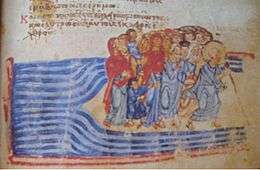
The fashion in all cathedral rites of the Mediterranean was a new emphasis on the psalter. In older ceremonies before Christianity became the religion of empires, the recitation of the biblical odes (mainly taken from the Old Testament) was much more important. They did not disappear in certain cathedral rites such as the Milanese and the Constantinopolitan rite.
Before long, however, a clericalizing tendency soon began to manifest itself in linguistic usage, particularly after the Council of Laodicea, whose fifteenth Canon permitted only the canonical psaltai, "chanters:", to sing at the services. The word choros came to refer to the special priestly function in the liturgy – just as, architecturally speaking, the choir became a reserved area near the sanctuary—and choros eventually became the equivalent of the word kleros (the pulpits of two or even five choirs).
The nine canticles or odes according to the psalter were:
- (1) The Song of the sea (Exodus 15:1–19);
- (2) The Song of Moses (Deuteronomy 32:1–43);
- (3) – (6) The prayers of Hannah, Habakkuk, Isaiah, Jonah (1 Kings [1 Samuel] 2:1–10; Habakkuk 3:1–19; Isaiah 26:9–20; Jonah 2:3–10);
- (7) – (8) The Prayer of Azariah and Song of the Three Holy Children (Apoc. Daniel 3:26–56 and 3:57–88);
- (9) The Magnificat and the Benedictus (Luke 1:46–55 and 68–79).
and in Constantinople they were combined in pairs against this canonical order:[30]
- Ps. 17 with troparia Ἀλληλούϊα and Μνήσθητί μου, κύριε.
- (1) with troparion Tῷ κυρίῳ ἄισωμεν, ἐνδόξως γὰρ δεδόξασται.
- (2) with troparion Δόξα σοι, ὁ θεός. (Deut. 1–14) Φύλαξόν με, κύριε. (Deut. 15–21) Δίκαιος εἶ, κύριε, (Deut. 22–38) Δόξα σοι, δόξα σοι. (Deut. 39–43) Εἰσάκουσόν μου, κύριε. (3)
- (4) & (6) with troparion Οἰκτείρησόν με, κύριε.
- (3) & (9a) with troparion Ἐλέησόν με, κύριε.
- (5) & Mannaseh (apokr. 2 Chr 33) with troparion Ἰλάσθητί μοι, κύριε.
- (7) which has a refrain in itself.
The troparion
The common term for a short hymn of one stanza, or one of a series of stanzas, is troparion. As a refrain interpolated between psalm verses it had the same function as the antiphon in Western plainchant. The simplest troparion was probably "allelouia", and similar to troparia like the trisagion or the cherubikon or the koinonika a lot of troparia became a chant genre of their own.
A famous example, whose existence is attested as early as the 4th century, is the Easter Vespers hymn, Phos Hilaron ("O Resplendent Light"). Perhaps the earliest set of troparia of known authorship are those of the monk Auxentios (first half of the 5th century), attested in his biography but not preserved in any later Byzantine order of service. Another, O Monogenes Yios ("Only Begotten Son"), ascribed to the emperor Justinian I (527–565), followed the doxology of the second antiphonon at the beginning of the Divine Liturgy.
Romanos the Melodist, the kontakion, and the Hagia Sophia

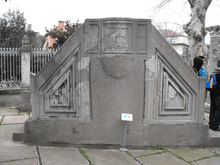
The development of large scale hymnographic forms begins in the fifth century with the rise of the kontakion, a long and elaborate metrical sermon, reputedly of Syriac origin, which finds its acme in the work of St. Romanos the Melodist (6th century). This dramatic homily, which usually paraphrases a Biblical narrative, comprises some 20 to 30 stanzas (oikoi "houses") and was sung during the Morning Office (Orthros) in a simple and direct syllabic style (one note per syllable).[31] The earliest musical versions in Italobyzantine kontakaria of the thirteenth century, however, are melismatic (that is, many notes per syllable of text), and were probably sung since the ninth century, when kontakia were reduced to the prooimion (introductory verse) and first oikos (stanza).[32] Romanos' own recitation of all the numerous oikoi must have been much simpler, but the most interesting question of the genre are the different functions that kontakia once had. Romanos' original melodies were not delivered by notated sources dating back to the 6th century, the earliest sources are the Slavonic Kondakars written down in Novgorod and Kiev during the 12th century. Their great signs are not identical with those of the Italian and Athonite Kontakaria of the 13th century. During the period of psaltic art (14th and 15th centuries), the interest of kalophonic elaboration was focussed on one particular kontakion which was still celebrated: the Akathist hymn. An exception was John Kladas who contributed also with kalophonic settings of other kontakia of the repertoire.
Some of them had a clear liturgical assignation, others not, so that they can only be understood from the background of the later book of ceremonies. Some of Romanos creations can be even regarded as political propaganda in connection with the new and very fast reconstruction of the famous Hagia Sophia by Isidore of Miletus and Anthemius of Tralles. A quarter of Constantinople had been burnt down during a civil war. Justinian had ordered a massacre at the hippodrome, because his imperial antagonists who were affiliated to the former dynasty, had been organised as a chariot team.[33] Thus, he had place for the creation of a huge park with a new cathedral in it, which was larger than any church built before as Hagia Sophia. He needed a kind of mass propaganda to justify the imperial violence against the public. In the kontakion "On earthquakes and conflagration" (H. 54), Romanos interpreted the Nika riot as a divine punishment, which followed in 532 earlier ones including earthquakes (526–529) and a famine (530):[34]
| The city was buried beneath these horrors and cried in great sorrow. | Ὑπὸ μὲν τούτων τῶν δεινῶν κατείχετο ἡ πόλις καὶ θρῆνον εἶχε μέγα· |
| Those who feared God stretched their hands out to him, | Θεὸν οἱ δεδιότες χεῖρας ἐξέτεινον αὐτῷ |
| begging for compassion and an end to the terror. | ἐλεημοσύνην ἐξαιτοῦντες παρ᾽ αὐτοῦ καὶ τῶν κακῶν κατάπαυσιν· |
| Reasonably, the emperor—and his empress—were in these ranks, | σὺν τούτοις δὲ εἰκότως ἐπηύχετο καὶ ὁ βασιλεύων |
| their eyes lifted in hope toward the Creator: | ἀναβλέψας πρὸς τὸν πλάστην —σὺν τούτῳ δὲ σύνευνος ἡ τούτου— |
| "Grant me victory", he said, "just as you made David | Δός μοι, βοῶν, σωτήρ, ὡς καὶ τῷ Δαυίδ σου |
| victorious over Goliath. You are my hope. | τοῦ νικῆσαι Γολιάθ· σοὶ γὰρ ἐλπίζω· |
| Rescue, in your mercy, your loyal people | σῶσον τὸν πιστὸν λαόν σου ὡς ἐλεήμων, |
| and grant them eternal life." | οἶσπερ καὶ δώσῃς ζωὴν τὴν αἰώνιον.(H. 54.18) |
According to Johannes Koder the kontakion was celebrated the first time during Lenten period in 537, about ten months before the official inauguration of the new built Hagia Sophia on 27 December.
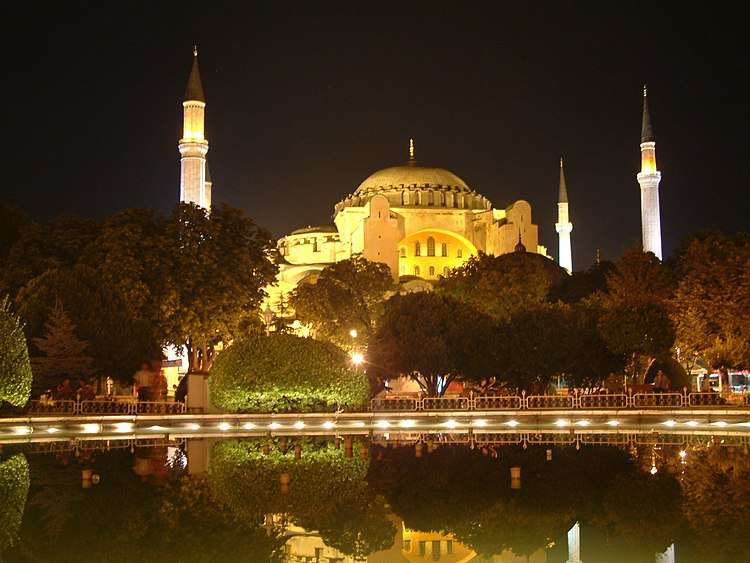
Changes in architecture and liturgy, and the introduction of the cherubikon
During the second half of the sixth century, there was a change in Byzantine sacred architecture, because the altar used for the preparation of the eucharist had been removed from the bema. It was placed in a separated room called "prothesis" (πρόθεσις). The separation of the prothesis where the bread was consecrated during a separated service called proskomide, required a procession of the gifts at the beginning of the second eucharist part of the divine liturgy. The troparion "Οἱ τὰ χερουβὶμ", which was sung during the procession, was often ascribed to Emperor Justin II, but the changes in sacred architecture were definitely traced back to his time by archaeologists.[35] Concerning the Hagia Sophia, which was constructed earlier, the procession was obviously within the church.[36] It seems that the cherubikon was a prototype of the Western chant genre offertory.[37]
With this change came also the dramaturgy of the three doors in a choir screen before the bema (sanctuary). They were closed and opened during the ceremony.[38] Outside Constantinople these choir or icon screens of marble were later replaced by iconostaseis. Antonin, a Russian monk and pilgrim of Novgorod, described the procession of choirs during Orthros and the divine liturgy, when he visited Constantinople in December 1200:
When they sing Lauds at Hagia Sophia, they sing first in the narthex before the royal doors; then they enter to sing in the middle of the church; then the gates of Paradise are opened and they sing a third time before the altar. On Sundays and feastdays the Patriarch assists at Lauds and at the Liturgy; at this time he blesses the singers from gallery, and ceasing to sing, they proclaim the polychronia; then they begin to sing again as harmoniously and as sweetly as the angels, and they sing in this fashion until the Liturgy. After Lauds they put off their vestments and go out to receive the blessing of the Patriarch; then the preliminary lessons are read in the ambo; when these are over the Liturgy begins, and at the end of the service the chief priest recites the so-called prayer of the ambo within the sanctuary while the second priest recites in the church, beyond the ambo; when they have finished the prayer, both bless the people. Vespers are said in the same fashion, beginning at an early hour.[39]
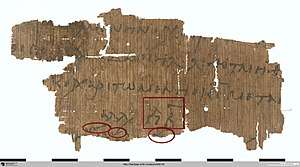
Monastic reforms in Constantinople and Jerusalem
By the end of the seventh century with the reform of 692, the kontakion, Romanos' genre was overshadowed by a certain monastic type of homiletic hymn, the kanon and its prominent role it played within the cathedral rite of the Patriarchate of Jerusalem. Essentially, the kanon is an hymnodic complex composed of nine odes that were originally attached to the nine Biblical canticles and to which they were related by means of corresponding poetic allusion or textual quotation (see the section about the biblical odes). Out of the custom of canticle recitation, monastic reformers at Constantinople, Jerusalem and Mount Sinai developed a new homiletic genre whose verses in the complex ode meter were composed over a melodic model: the heirmos.[40]
The nine odes of the kanon were dissimilar by their metrum. Consequently, an entire heirmos comprises nine independent melodies (eight, because the second ode was usually omitted outside Lenten period), which are united musically by the same echos and its melos, and sometimes even textually by references to the general theme of the liturgical occasion—especially in acrosticha composed over a given heirmos, but dedicated to a particular day of the menaion.
The earliest examples were already composed by Severus of Antioch, Paul of Edessa and Ioannes Psaltes at the Patriarchate of Antioch between 512 and 518. Their tropologion has only survived in Syriac translation and revised by Jacob of Edessa.[41] The tropologion was continued by Sophronius, Patriarch of Jerusalem, but especially by Andrew of Crete's contemporary Germanus I, Patriarch of Constantinople who represented as a gifted hymnographer not only an own school, but he became also very eager to realise the purpose of this reform since 705, although its authority was questioned by iconoclast antagonists and only established in 787. After the octoechos reform of the Quinisext Council in 692, monks at Mar Saba continued the hymn project under Andrew's instruction, especially by his most gifted followers John of Damascus and Cosmas of Jerusalem. These various layers of the Hagiopolitan tropologion since the 5th century have mainly survived in a Georgian type of tropologion called "Iadgari" whose oldest copies can be dated back to the 9th century.[42]
Today the second ode is usually omitted (according to the so-called "golden canon" attributed to John of Damascus), but medieval heirmologia rather testify the custom, that the extremely strict spirit of Moses' last prayer was especially recited during Lenten tide, when the number of odes was limited, especially patriarch Germanus I contributed with many own compositions of the second ode. According to Alexandra Nikiforova only two of 64 canons composed by Germanus I are present in the current print editions, but manuscripts have transmitted his hymnographic heritage.[43]
The monastic reform of the Stoudites and their notated chant books
During the 9th-century reforms of the Stoudios Monastery, the reformers favoured Hagiopolitan composers and customs in their new notated chant books heirmologion and sticherarion, but they also added substantial parts to the tropologion and re-organised the cycle of movable and immovable feasts (especially Lent, the triodion, and its scriptural lessons).[44] The trend is testified by a 9th-century tropologion of the Saint Catherine's Monastery which is dominated by contributions of Jerusalem.[45] Festal stichera, accompanying both the fixed psalms at the beginning and end of Hesperinos and the psalmody of the Orthros (the Ainoi) in the Morning Office, exist for all special days of the year, the Sundays and weekdays of Lent, and for the recurrent cycle of eight weeks in the order of the modes beginning with Easter. Their melodies were originally preserved in the tropologion. During the 10th century two new notated chant books were created at the Stoudios Monastery, which were supposed to replace the tropologion:
- the sticherarion, consisting of the idiomela in the menaion (the fixed cycle between September and August), the triodion and the pentekostarion (mobile cycle around the holy week), and the short version of octoechos (hymns of the Sunday cycle starting with Saturday evening) which sometimes contained a limited number of model troparia (prosomoia). A rather bulky volume called "great octoechos" or "parakletike" with the weekly cycle appeared first in the middle of the tenth century as a book of its own.[46]
- the heirmologion, which was composed in eight parts for the eight echoi, and further on either according to the canons in liturgical order (KaO) or according to the nine odes of the canon as a subdivision into 9 parts (OdO).
These books were not only provided with musical notation, with respect to the former tropologia they were also considerably more elaborated and varied as a collection of various local traditions. In practice it meant that only a small part of the repertory was really chosen to be sung during the divine services.[47] Nevertheless, the form tropologion was used until the 12th century, and many later books which combined octoechos, sticherarion and heirmologion, rather derive from it (especially the usually unnotated Slavonic osmoglasnik which was often divided in two parts called "pettoglasnik", one for the kyrioi, another for the plagioi echoi).
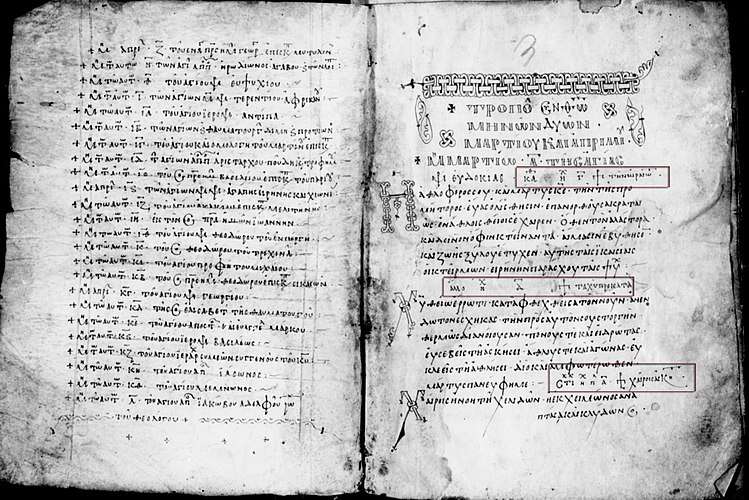
The old custom can be studied on the basis of the 9th-century tropologion ΜΓ 56+5 from Sinai which was still organised according to the old tropologion beginning with the Christmas and Epiphany cycle (not with 1 September) and without any separation of the movable cycle.[48] The new Studite or post-Studite custom established by the reformers was that each ode consists of an initial troparion, the heirmos, followed by three, four or more troparia from the menaion, which are the exact metrical reproductions of the heirmos (akrostics), thereby allowing the same music to fit all troparia equally well. The combination of Constantinopolitan and Palestine customs must be also understood on the base of the political history.[49]
.jpg)
Especially the first generation around Theodore Studites and Joseph the Confessor, and the second around Joseph the Hymnographer suffered from the first and the second crisis of iconoclasm. The community around Theodore could revive monastic life at the abandoned Stoudios Monastery, but he had to leave Constantinople frequently in order to escape political persecution. During this period, the Patriarchates of Jerusalem and Alexandria (especially Sinai) remained centres of the hymnographic reform. Concerning the Old Byzantine notation, Constantinople and the area between Jerusalem and Sinai can be clearly distinguished. The earliest notation used for the books sticherarion and was theta notation, but it was soon replaced by palimpsests with more detailed forms between Coislin (Palestine) and Chartres notation (Constantinople). Although it was correct that the Studites in Constantinople established a new mixed rite, its customs remained different from those of the other Patriarchates which were located outside the Empire.
On the other hand, Constantinople as well as other parts of the Empire like Italy encouraged also privileged women to found female monastic communities and certain hegumeniai also contributed to the hymnographic reform.[50] The basic repertoire of the newly created cycles the immovable menaion, the movable triodion and pentekostarion and the week cycle of parakletike and Orthros cycle of the eleven stichera heothina and their lessons are the result of a redaction of the tropologion which started with the generation of Theodore the Studite and ended during the Macedonian Renaissance under the emperors Leo VI (the stichera heothina are traditionally ascribed to him) and Constantine VII (the exaposteilaria anastasima are ascribed to him).
The cyclic organization of lectionaries
Another project of the Studites' reform was the organisation of the of New Testament (Epistle, Gospel) reading cycles, especially its hymns during the period of the triodion (between the pre-Lenten Meatfare Sunday called "Apokreo" and the Holy Week).[51] Older lectionaries had been often completed by the addition of ekphonetic notation and of reading marks which indicate the readers where to start (ἀρχή) and to finish (τέλος) on a certain day.[52] The Studites also created a typikon—a monastic one which regulated the cœnobitic life of the Stoudios Monastery and granted its autonomy in resistance against iconoclast Emperors, but thy had also an ambitious liturgical programme which imported Hagiopolitan customs (of Jerusalem) like the Great Vesper, especially for the movable cycle between Lent and Allsaints (triodion and pentekostarion), including a Sunday of Orthodoxy which celebrated the triumph over iconoclasm on the first Sunday of Lent.[53]
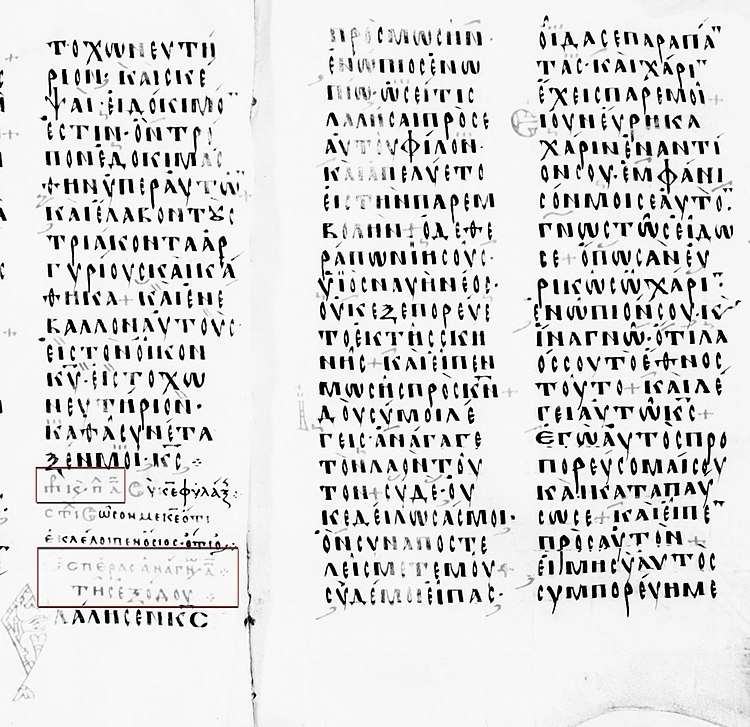
Unlike the current Orthodox custom Old Testament readings were particular important during Orthros and Hesperinos in Constantinople since the 5th century, while there was no one during the divine liturgy.[54] The Great Vespers according to Studite and post-Studite custom (reserved for just a few feasts like the Sunday of Orthodoxy) were quite ambitious. The evening psalm 140 (kekragarion) was based on simple psalmody, but followed by florid coda of a soloist (monophonaris). A melismatic prokeimenon was sung by him from the ambo, it was followed by three antiphons (Ps 114-116) sung by the choirs, the third used the trisagion or the usual anti-trisagion as a refrain, and an Old Testament reading concluded the prokeimenon.[55]
The Hagiopolites treatise
The earliest chant manual pretends right at the beginning that John of Damascus was its author. Its first edition was based on a more or less complete version in a 14th-century manuscript,[56] but the treatise was probably created centuries earlier as part of the reform redaction of the tropologia by the end of the 8th century, after Irene's Council of Nikaia had confirmed the octoechos reform of 692 in 787. It fits well to the later focus on Palestine authors in the new chant book heirmologion.
Concerning the octoechos, the Hagiopolitan system is characterised as a system of eight diatonic echoi with two additional phthorai (nenano and nana) which were used by John of Damascus and Cosmas, but not by Joseph the Confessor who obviously preferred the diatonic mele of plagios devteros and plagios tetartos.[57]
It also mentions an alternative system of the Asma (the cathedral rite was called ἀκολουθία ᾀσματική) that consisted of 4 kyrioi echoi, 4 plagioi, 4 mesoi, and 4 phthorai. It seems that until the time, when the Hagiopolites was written, the octoechos reform did not work out for the cathedral rite, because singers at the court and at the Patriarchate still used a tonal system of 16 echoi, which was obviously part of the particular notation of their books: the asmatikon and the kontakarion or psaltikon.
But neither any 9th-century Constantinopolitan chant book nor an introducing treatise that explains the fore-mentioned system of the Asma, have survived. Only a 14th-century manuscript of Kastoria testifies cheironomic signs used in the Kontakarion, which are transcribed in longer melodic phrases by the notation of the contemporary sticherarion, the middle Byzantine Round notation.
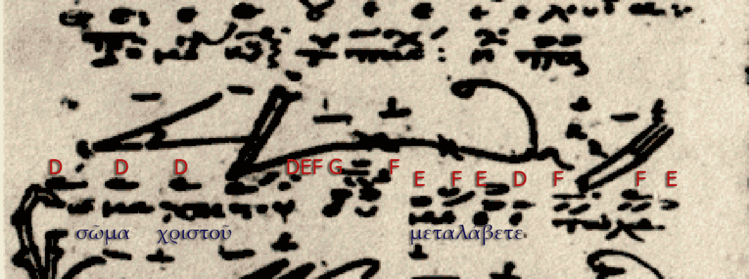
The transformation of the kontakion
The former genre and glory of Romanos' kontakion was not abandoned by the reformers, even contemporary poets in a monastic context continued to compose new liturgical kontakia (mainly for the menaion), it likely preserved a modality different from Hagiopolitan oktoechos hymnography of the sticherarion and the heirmologion.
But only a limited number of melodies or kontakion mele had survived. Some of them were rarely used to compose new kontakia, other kontakia which became the model for eight prosomoia called “kontakia anastasima” according the oktoechos, had been frequently used. The kontakion ὁ ὑψωθεῖς ἐν τῷ σταυρῷ for the feast of cross exaltation (14 September) was not the one chosen for the prosomoion of the kontakion anastasimon in the same echos, it was actually the kontakion ἐπεφάνης σήμερον for Theophany (6 January). But nevertheless, it represented the second important melos of the echos tetartos which was frequently chosen to compose new kontakia, either for the prooimion (introduction) or for the oikoi (the stanzas of the kontakion called “houses”). Usually these models were not rubrified as “avtomela”, but as idiomela which means that the modal structure of a kontakion was more complex, similar to a sticheron idiomelon changing through different echoi.
This new monastic type of kontakarion can be found in the collection of Saint Catherine's Monastery on the peninsula of Sinai (ET-MSsc Ms. Gr. 925-927) and its kontakia had only a reduced number of oikoi. The earliest kontakarion (ET-MSsc Ms. Gr. 925) dating to the 10th century might serve as an example. The manuscript was rubrified Κονδακάριον σῦν Θεῷ by the scribe, the rest is not easy to decipher since the first page was exposed to all kinds of abrasion, but it is obvious that this book is a collection of short kontakia organised according to the new menaion cycle like a sticherarion, beginning with 1 September and the feast of Symeon the Stylite. It has no notation, instead the date is indicated and the genre κονδάκιον is followed by the dedicated Saint and the incipit of the avtomelon (not even with an indication of its echos by a modal signature in this case).
Folio 2 verso shows a kontakion ἐν ἱερεῦσιν εὐσεβῶς διαπρέψας which was composed over the prooimion used for the kontakion for cross exaltation ὁ ὑψωθεῖς ἐν τῷ σταυρῷ. The prooimion is followed by four stanzas called oikoi, but they all share with the prooimion the same refrain ταὶς σαῖς πρεσβεῖαις which concludes each oikos. But the model for these oikoi was not taken from the same kontakion, but from the other kontakion for Theophany whose first oikos had the incipit τῇ γαλιλαίᾳ τῶν ἐθνῶν.

The Slavic reception

The Slavic reception is crucial for the understanding, how the kontakion has changed under the influence of the Stoudites. During the 9th century new Empires established in the North which were dominated by Slavic populations (mainly the first Bulgarian Empire, with two new literary centres at Preslav and the Lake Ohrid, and the Kievan Rus', a federation of East Slavic tribes between the Black Sea and Scandinavia, after similar plans failed for Great Moravia), and these empires requested a state religion, legal codexes, the translation of canonic scriptures, but also the translation of an overregional liturgy as it was created by the Stoudios Monastery, Mar Saba and Saint Catherine's Monastery. The Slavic reception confirmed this new trend, but also showed a detailed interest for the cathedral rite of the Hagia Sophia and the pre-Stoudite organisation of the tropologion. Thus, these manuscripts are not only the earliest literary evidence of Slavonic languages which offer evidence to the local variants of the language, but also the earliest sources of the Constantinopolitan cathedral rite with musical notation, although transcribed into a notation of its own, just based on one tone system and on the contemporary layer of 11th-century notation, the roughly diastematic Old Byzantine notation.
The Ohrid Literary School
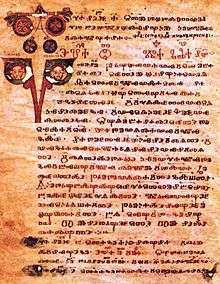
Unfortunately there is no Slavonic tropologion written in Glagolitic script by Cyril and Methodius which has survived from their time. This lack of evidence does not prove that it had not existed, since certain conflicts with Benedictines and other Slavonic missionaries in Great Moravia and Pannonia were obviously about an Orthodox rite translated into Old Church Slavonic and practised already by Methodius and Clement of Ohrid.[58] The only early Glagolitic source left is the Kiev Missal which proves a West Roman influence in the Old Slavonic liturgy for certain territories of Croatia, and a later 11th-century New Testament lectionary known as the Codex Assemanius which was obviously created by the Ohrid Literary School, and a euchologion (ET-MSsc Ms. Slav. 37) in part compiled for Great Moravia by Cyril and Clement of Preslav and probably copied at Preslav about the same time. The aprakos lectionary proves that the Stoudites typikon was obeyed concerning the organisation of reading cycles. It explains, why Svetlana Kujumdžieva assumed that the “church order” mentioned in Methodius' vita meant the mixed Constantinopolitan Sabbaite rite established by the Stoudites. But a later finding by the same author pointed to another direction.[59] In a recent publication she chose "Iliya's book" (RUS-Mda Fond 381, Ms. 131) as the earliest example of an Old Church Slavonic tropologion (around 1100), it has compositions by Cyril of Jerusalem and agrees about 50% with the earliest tropologion of Sinai (ET-MSsc Ms. NE/MΓ 56+5) and it is likewise organised as a mеnaion (beginning with September like the Stoudites), but it still includes the movable cycle. Hence, its organisation is still close to the tropologion and it has compositions not only ascribed to Cosmas and John, but also Stephen the Sabaite, Theophanes the Branded, the Georgian scribe and hymnographer Basil at Mar Saba and Joseph the Hymnographer. Further on, musical notation has been added on some pages which reveal an exchange between Slavic literary schools and scribes of Sinai or Mar Saba:
- theta ("θ" for "thema" which indicates a melodic figure over certain syllables of the text) or fita notation was used to indicate the melodic structure of an idiomelon/samoglasen in glas 2 "Na Iordanstei rece" (Epiphany, f.109r). It was also used on other pages (kanon for hypapante, ff.118v-199r & 123r),
- two forms of znamennaya notation, an earlier one has dots on the right sight of certain signs (the kanon "Obraza drevle Moisi" in glas 8 for Cross elevation on 14 September, ff.8r-9r), and a more developed form which was obviously needed for a new translation of the text ("another" avtomelon/samopodoben, ино, glas 6 "Odesnuyu spasa" for Saint Christina of Tyre, 24 July, f.143r).[60]
.jpg)
Kujumdžieva pointed later at a Southern Slavic origin (also based on linguistic arguments since 2015), although feasts of local saints, celebrated on the same day like Christina Boris and Gleb, had been added. If its reception of a pre-Stoudite tropologion was of Southern Slavic origin, there is evidence that this manuscript was copied and adapted for a use in Northern Slavic territories.
Recent systematic editions of the early sources (in menaion order) have revealed that the philosophy of the literary schools in Ohrid and Preslav did only require in exceptional cases the use of notation.[61] The reason is that their translation of Greek hymnography were not very literal, but often quite far from the content of the original texts, the main concern of this school was the recomposition or troping of the given system of melodies (with their models known as avtomela and heirmoi) which was left intact. The so-called "Iliya's book" can hardly serve as an evidence for an early Southern Slavic reception, it rather proves that notation was only used in a few parts, where a new translation of a certain text required a new melodic composition which was no longer included within the existing system of melodies established by the Stoudites and their followers. But there is a coincidence between the early fragment from the Berlin-collection, where the ἀλλὸ rubric is followed by a modal signature and some early neumes, while the elaborated zamennaya is used for a new sticheron (ино) dedicated to Saint Christina.
The Kievan Rus' and the earliest manuscripts of the cathedral rite
Concerning the Slavic rite celebrated in various parts of the Kievan Rus', there was not only an interest for the organisation of monastic chant and the tropologion and the oktoich or osmoglasnik which included chant of the irmolog, podobni (prosomoia) and their models (samopodobni), but also the samoglasni (idiomela) like in case of Iliya's book.
Znamennaya notation in the stichirar and the irmolog
Since the 12th century, there are also Slavic stichirars which did not only include the samoglasni, but also the podobni provided with znamennaya notation. A comparison of the very first samoglasen наста въходъ лѣтѹ (“Enter the entrance of the annual cycle”) in glas 1 (ἐπέστη ἡ εἴσοδος ἐνιαυτοῦ echos protos, SAV 1[62]) of the miney shows, that the znamennaya version is much closer to fita (theta) notation, since the letter “θ =” corresponds to other signs in Coislin and a synthetic way to write a kratema group in Middle Byzantine notation. It was obviously an elaboration of the simpler version written in Coislin:
The Middle Byzantine version allows to recognise the exact steps (intervals) between the neumes. They are here described according to the Papadic practice of solfège called "parallage" (παραλλαγή) which is based on echemata: for ascending steps always kyrioi echoi are indicated, for descending steps always echemata of the plagioi echoi. If the phonic steps of the neumes were recognised according to this method, the resulting solfège was called "metrophonia". The step between the first neumes at the beginning passed through the protos pentachord between kyrios (a) and plagios phthongos (D): a—Da—a—G—a—G—FGa—a—EF—G—a—acbabcba. The Coislin version seems to end (ἐνιαυτοῦ) thus: EF—G—a—Gba (the klasma indicates that the following kolon continues immediately in the music). In znamennaya notation the combination dyo apostrophoi (dve zapĕtiye) and oxeia (strela) at the beginning (наста) is called "strela gromnaya" and obviously derived from the combination "apeso exo" in Coislin notation. According to the customs of Old Byzantine notation, "apeso exo" was not yet written with "spirits" called "chamile" and "hypsile" which did later specify as pnevmata the interval of a fifth (four steps). As usual the Old Church Slavonic translation of the text deals with less syllables than the Greek verse. It should be noted that the neumes only show the basic structure which was memorised as metrophonia by the use of parallage, not the melos of the performance. The melos depended on various methods to sing an idiomelon, either together with a choir or to ask a soloist to create a rather individual version (changes between soloist and choir were at least common for the period of the 14th century, when the Middle Byzantine sticherarion in this example was created). But the comparison clearly reveals the potential (δύναμις) of the rather complex genre idiomelon.
Reception of the cathedral rite
In the Primary Chronicle (Повѣсть времѧньныхъ лѣтъ "tale of passed years") it is reported, how a legacy of the Rus' was received in Constantinople and how they did talk about their experience in presence of Vladimir the Great in 987, before the Grand Prince Vladimir decided about the Christianization of the Kievan Rus' (Laurentian Codex written at Nizhny Novgorod in 1377):
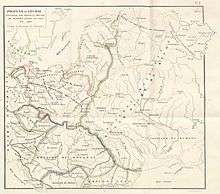
| “ | On the morrow, the Byzantine emperor sent a message to the patriarch to inform him that a Russian delegation had arrived to examine the Greek faith, and directed him to prepare the church Hagia Sophia and the clergy, and to array himself in his sacerdotal robes, so that the Russians might behold the glory of the God of the Greeks. When the patriarch received these commands, he bade the clergy assemble, and they performed the customary rites. They burned incense, and the choirs sang hymns. The emperor accompanied the Russians to the church, and placed them in a wide space, calling their attention to the beauty of the edifice, the chanting, and the offices of the archpriest and the ministry of the deacons, while he explained to them the worship of his God. The Russians were astonished, and in their wonder praised the Greek ceremonial. Then the Emperors Basil and Constantine invited the envoys to their presence, and said, "Go hence to your native country," and thus dismissed them with valuable presents and great honor.
Thus they returned to their own country, and the prince called together his vassals and the elders. Vladimir then announced the return of the envoys who had been sent out, and suggested that their report be heard. He thus commanded them to speak out before his vassals. The envoys reported: "When we journeyed among the Bulgars, we beheld how they worship in their temple, called a mosque, while they stand ungirt. The Bulgarian bows, sits down, looks hither and thither like one possessed, and there is no happiness among them, but instead only sorrow and a dreadful stench. Their religion is not good. Then we went among the Germans, and saw them performing many ceremonies in their temples; but we beheld no glory there. Then we went on to Greece, and the Greeks led us to the edifices where they worship their God, and we knew not whether we were in heaven or on earth. For on earth there is no such splendor or such beauty, and we are at a loss how to describe it. We know only that God dwells there among men, and their service is fairer than the ceremonies of other nations. For we cannot forget that beauty. Every man, after tasting something sweet, is afterward unwilling to accept that which is bitter, and therefore we cannot dwell longer here.[63] |
” |
There was obviously also an interest in the representative aspect of those ceremonies at the Hagia Sophia of Constantinople. Today, it is still documented by seven Slavic kondakars. Six of them had been written in scriptoria of Kievan Rus' during the 12th and the 13th centuries, while there is one later kondakar without notation which was written in the Balkans during the 14th century. The aesthetic of the kalligraphy and the notation has so developed over a span of 100 years that it must be regarded as a local tradition, but also one which provided us with the earliest evidence of the cheironomic signs which had only survived in one later Greek manuscript.
In 1147, the chronicler Eude de Deuil described during a visit of the Frankish King Louis VII the cheironomia, but also the presence of eunuchs during the cathedral rite. With respect to the custom of the Missa greca (for the patron of the Royal Abbey of Saint Denis), he reported that the Byzantine emperor sent his clerics to celebrate the divine liturgy for the Frankish visitors:
| “ | Novit hoc imperator; colunt etenim Graeci hoc festum, et clericorum suorum electam multitudinem, dato unicuique cereo magno, variis coloribus et auro depicto regi transmisit, et solemnitatis gloriam ampliavit. Illi quidem a nostris clericis verborum et organi genere dissidebant, sed suavi modulatione placebant. Voces enim mistae, robustior cum gracili, eunucha videlicet cum virili (erant enim eunuchi multi illorum), Francorum animos demulcebant. Gestu etiam corporis decenti et modesto, plausu manuum, et inflexione articulorum, jucunditatem visibus offerebant.[64]
Since the emperor realised, that the Greeks celebrate this feast, he sent to the king a selected group of his clergy, each of whom he had equipped with a large taper [votive candle] decorated elaborately with gold and a great variety of colours; and he increased the glory of the ceremony. Those differed from our clerics concerning the words and the order of service, but they pleased us with sweet modulations. You should know that the mixed voices are more stable but with grace, the eunuchs appear with virility (for many of them were eunuchs), and softened the hearts of the Franks. Through a decent and modest gesture of the body, clapping of hands and flexions of the fingers they offered us a vision of gentleness. |
” |
Kondakarian notation of the asmatikon part
The Kievan Rus' obviously cared about this tradition, but especially about the practice of cheironomia and its particular notation: the so-called “Kondakarian notation”. A comparison with Easter koinonikon proves two things: the Slavic kondakar did not correspond to the “pure” form of the Greek kontakarion which was the book of the soloist who had also to recite the larger parts of the kontakia or kondaks. It was rather a mixed form which included also the choir book (asmatikon), since there is no evidence that such an asmatikon had ever been used by clerics of the Rus', while the Kondakarian notation integrated the cheironomic signs with simple signs, a Byzantine convention which had only survived in one manuscript (GR-KA Ms. 8), and combined it with Old Slavic znamennaya notation, as it had been developed in the sticheraria and heirmologia of the 12th century and the so-called Tipografsky Ustav.[65]
Although the common knowledge of znamennaya notation is as limited as the one of other Old Byzantine variants such as Coislin and Chartres notation, a comparison with the asmatikon Kastoria 8 is a kind of bridge between the former concept of cheironomiai as the only authentic notation of the cathedral rite and the hand signs used by the choir leaders and the later concept of great signs integrated and transcribed into Middle Byzantine notation, but it is a pure form of the choir book, so that such comparison is only possible for an asmatic chant genre such as the koinonikon.
See for instance the comparison of the Easter koinonikon between the Slavic Blagoveščenskiy kondakar which was written about 1200 in the Northern town Novgorod of the Rus', its name derived from its preservation at the collection of the Blagoveščenskiy monastery at Nizhny Novgorod.
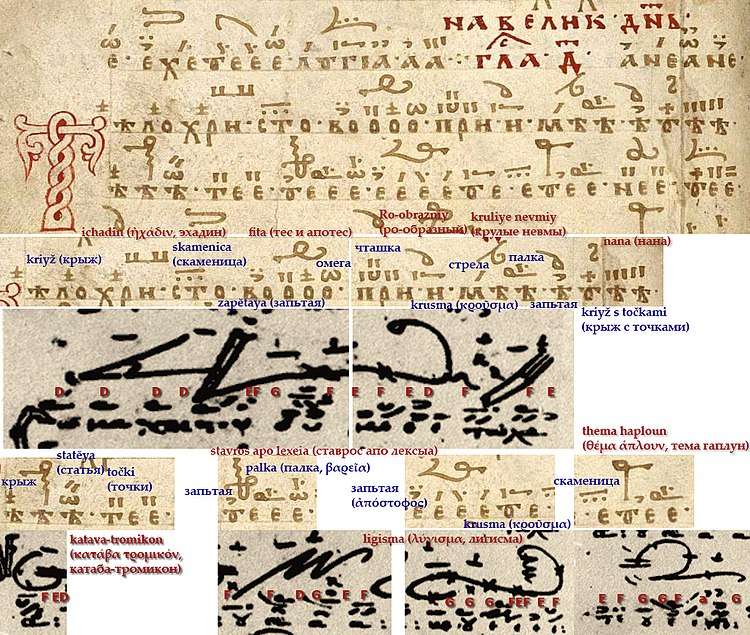

The comparison should not suggest that both versions are identical, but the earlier source documents an earlier reception of the same tradition (since there is a difference about 120 years between both sources it is impossible to judge the differences). The rubric “Glas 4” is most likely an error of the notator and meant “Glas 5”, but it is also possible, that the Slavic tone system was already in such an early period organised in triphonia. Thus, it could also mean that анеане, undoubtly the plagios protos enichima ἀνεανὲ, was supposed to be on a very high pitch (about an octave higher), in that case the tetartos phthongos has not the octave species of tetartos (a tetrachord up and a pentachord down), but the one of plagios protos. The comparison also shows very much likeness between the use of asmatic syllables such as “ѹ” written as one character such as “ɤ”. Tatiana Shvets in her description of the notational style also mentions the kola (frequent interpunction within the text line) and medial intonations can appear within a word which was sometimes due to the different numbers of syllables within the translated Slavonic text. A comparison of the neumes also show many similarities to Old Byzantine (Coislin, Chartres) signs such as ison (stolpička), apostrophos (zapĕtaya), oxeia (strela), vareia (palka), dyo kentimata (točki), dipli (statĕya), klasma (čaška), the krusma (κροῦσμα) was actually an abbreviation for a sequence of signs (palka, čaška and statĕya) and omega "ω" meant a parakalesma, a great sign related to a descending step (see the echema for plagios protos: it is combined with a dyo apostrophoi called "zapĕtaya").[66]
Another very modern part of the Blagoveščenskiy kondakar was a Polyeleos composition (a post-Stoudites custom, since they imported the Great Vesper from Jerusalem) about the psalm 135 which was divided into eight sections, each one in another glas:
- Glas 1: Ps. 135:1-4 (RUS-SPsc Ms. Q.п.I.32, f.107r).
- Glas 2: Ps. 135:5-8 (RUS-SPsc Ms. Q.п.I.32, f.107v).
- Glas 3: Ps. 135:9-12 (RUS-SPsc Ms. Q.п.I.32, f.108v).
- Glas 4: Ps. 135:13-16 (RUS-SPsc Ms. Q.п.I.32, f.109v).
- Glas 5: Ps. 135:17-20 (RUS-SPsc Ms. Q.п.I.32, f.110r).
- Glas 6: Ps. 135:21-22 (RUS-SPsc Ms. Q.п.I.32, f.110v).
- Glas 7: Ps. 135:23-24 (RUS-SPsc Ms. Q.п.I.32, f.112r).
- Glas 8: Ps. 135:25-26 (RUS-SPsc Ms. Q.п.I.32, f.113r).
The refrain алелɤгιа · алелɤгιа · ананҍанҍс · ꙗко въ вҍкы милость ѥго · алелɤгιа (“Alleluia, alleluia. medial intonation For His love endureth forever. Alleluia.“) was only written after a medial intonation for the conclusion of the first section. “Ananeanes” was the medial intonation of echos protos (glas 1).[67] This part was obviously composed without modulating to the glas of the following section. The refrain was likely sung by the right choir after the intonation of its leader: the domestikos, the preceding psalm text probably by a soloist (monophonaris) from the ambo. Interesting is that only the choir sections are entirely provided with cheironomiai. Slavic cantors had been obviously trained in Constantinople to learn the hand signs which corresponded to the great signs in the first row of Kondakarian notation, while the monophonaris parts had them only at the end, so that they were probably indicated by the domestikos or lampadarios in order to get the attention of the choir singers, before singing the medial intonations.
We do not know, whether the whole psalm was sung or each section at another day (during the Easter week, for instance, when the glas changed daily), but the following section do not have a written out refrain as a conclusion, so that the first refrain of each section was likely repeated as conclusion, often with more than one medial intonation which indicated, that there was an alternation between the two choirs. For instance within the section of glas 3 (the modal signature was obviously forgotten by the notator), where the text of the refrain is almost treated like a "nenanismaton": “але-нь-н-на-нъ-ъ-на-а-нъ-ı-ъ-лɤ-гı-а”.[68] The following medial intonations “ипе” (εἴπε “Say!”) and “пал” (παλὶν “Again!”) obviously did imitate medial intonations of the asmatikon without a true understanding of their meaning, because a παλὶν did usually indicate that something will be repeated from the very beginning. Here one choir did obviously continue another one, often interrupting it within a word.
The end of the cathedral rite at Constantinople
1207, when the Uspensky kondakar was written, the traditional cathedral rite had no longer survived in Constantinople, because the court and the patriarchate had gone into exile to Nikaia in 1204, after Western crusaders had made it impossible to continue the local tradition. The Greek books of the asmatikon (choir book) and the monophonaris (the psaltikon which often included the kontakarion) were written outside Constantinople, on the island of Patmos, at Saint Catherine's monastery, on the Holy Mount Athos and in Italy, in a new notation which developed some decades later within the books sticherarion and heirmologion: Middle Byzantine round notation. Thus, also the book kontakarion-psaltikon dedicated to the Constantinopolitan cathedral rite must be regarded as part of its reception history outside Constaninople like the Slavic kondakar.
The era of psaltic art and the new mixed rite of Constantinople
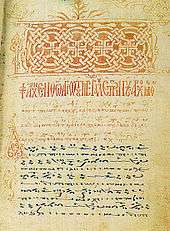
With the end of creative poetical composition, Byzantine chant entered its final period, devoted largely to the production of more elaborate musical settings of the traditional texts: either embellishments of the earlier simpler melodies, or original music in highly ornamental style. This was the work of the so-called Maïstores, “masters, of whom the most celebrated was St. John Koukouzeles (active c. 1300), compared in Byzantine writings to St. John of Damascus himself, as an innovator in the development of chant. The multiplication of new settings and elaborations of the old continued in the centuries following the fall of Constantinople, until by the end of the eighteenth century the original musical repertory of the medieval musical manuscripts had been quite replaced by later compositions, and even the basic model system had undergone profound modification.
Ottoman era
Petros Bereketes and the school of the Phanariotes
To a certain degree there may be found remnants of Byzantine or early (Greek-speaking, Orthodox Christian) near eastern music in the music of the Ottoman Court. Examples such as that of the composer and theorist Prince Cantemir of Romania learning music from the Greek musician Angelos, indicate the continuing participation of Greek speaking people in court culture. The influences of ancient Greek basin and the Greek Christian chants in the Byzantine music as origin, are confirmed. Music of Turkey was influenced by Byzantine music, too (mainly in the years 1640–1712).[69] Ottoman music is a synthesis, carrying the culture of Greek and Armenian Christian chant. It emerged as the result of a sharing process between the many civilizations that met together in the Orient, considering the breadth and length of duration of these empires and the great number of ethnicities and major or minor cultures that they encompassed or came in touch with at each stage of their development.
The Orthodox reformulation according to the new method
Chrysanthos of Madytos (ca. 1770–1846), Gregory the Protopsaltes (c. 1778 – c. 1821), and Chourmouzios the Archivist were responsible for a reform of the notation of Greek ecclesiastical music. Essentially, this work consisted of a simplification of the Byzantine Musical Symbols that, by the early 19th century, had become so complex and technical that only highly skilled chanters were able to interpret them correctly. The work of the three reformers is a landmark in the history of Greek Church music, since it introduced the system of neo-Byzantine music upon which are based the present-day chants of the Greek Orthodox Church. Unfortunately, their work has since been misinterpreted often, and much of the oral tradition has been lost.
The Simon Karas school at Athens
Simon Karas[70] (1905–1999) began an effort to assemble as much material as possible in order to restore the apparently lost tradition. His work was continued by Lycourgos Angelopoulos and other psaltai (“cantors”) of Byzantine music, until his death 18 May 2014. Two major styles of interpretation have evolved, the Hagioritic, which is simpler and is mainly followed in monasteries, and the Patriarchal, as exemplified by the style taught at the Great Church of Constantinople, which is more elaborate and is practised in parish churches. Nowadays the Orthodox churches maintain chanting schools in which new cantors are trained. Each diocese employs a protopsaltes ("first cantor"), who directs the diocesan cathedral choir and supervises musical education and performance. The protopsaltes of the Patriarchates are given the title Archon Protopsaltes ("Lord First Cantor"), a title also conferred as an honorific to distinguished cantors and scholars of Byzantine music.
See also
- Byzantine Musical Symbols
- Music of ancient Rome
- Ancient Greek music
- Modern Greek music
- Traditional music of Crete
- The Lyra of the Byzantine
- Museum of Ancient Greek, Byzantine and Post-Byzantine Instruments
- Znamenny chant – the Russian chant style that evolved from the Byzantine system
For more on the theory of Byzantine music and its cultural relatives in Greek-speaking peoples see:
For collections of Byzantine hymnography see:
For contemporary works featuring Byzantine chant see:
References
- ↑ "The origin of Byzantine music" Institute For Research On Music And Acoustics
- ↑ Neubauer, Eckhard (1994). "Die acht "Wege" der arabischen Musiklehre und der Oktoechos – Ibn Misğah, al-Kindī und der syrisch-byzantinische oktōēchos". Zeitschrift für Geschichte der arabisch-islamischen Wissenschaften. 9: 373–414.
- ↑ The acts of the Quinisext Council condemned many Constantinopolitan customs, including certain phthorai and mesoi used by chanters of the cathedral rite. The Stoudites reforms were influenced by the Second Council of Nicaea (787), which confirmed the Octoechos reform for Eastern and Western chant. The typikon of Theodore has not survived, but it must have adopted Hagiopolitan customs of Mar Saba.
- ↑ "The use of the organ in the Orthodox Church"
- ↑ Troelsgård, Christian (2007). "A New Source for the Early Octoechos? Papyrus Vindobonensis G 19.934 and its musical implications". Proceedings of the 1st International Conference of the ASBMH (PDF). pp. 668–679. Retrieved 14 April 2012.
- ↑ Constantelos, Demetrios (1998). "The Formation of the Hellenic Christian Mind". Christian Hellenism. Essays and Studies in Continuity and Change. New Rochelle, New York & Athens: Caratzas. ISBN 0-89241-588-6.
- ↑ John of Damascus (1958). Πηγή Γνώσεως. New York. p. 12.
- ↑ PG 94, col. 533.
- ↑ Ptolemy's harmonics are the concluding main reference in didactic writings of Georgius Pachymeres and Manuel Bryennios, except the Aristoxenian fragments, and later authors including Nichomachus, Cleonides, Theon of Smyrna, and Aristides Quintilianus (2nd-4th century). All Byzantine authors teach harmonics as a mathematic science without any concern over contemporary composition. Wolfram, Gerda (2001). "Fragen der Kontinuität zwischen antiker und byzantinischer Musiktheorie" (PDF). Cantus Planus: Papers read at the ninth meeting. Budapest: Magyar Tudomanyos Akademia. pp. 575–584.
- 1 2 Ring, Trudy (1994). International Dictionary of Historic Places: Middle East and Africa. 4. Taylor & Francis. ISBN 1884964036.
- ↑ Kartomi 1990, p. 124.
- ↑ "lira". Encyclopædia Britannica. 2009.
- ↑ Arkenberg, Rebecca (October 2002). "Renaissance Violins". Metropolitan Museum of Art. Retrieved 2006-09-22.
- ↑ Journal of Sport History, Vol. 8, No. 3 (Winter, 1981) p. 44.
- 1 2 Douglas Earl Bush, Richard Kassel editors, The Organ: An Encyclopedia Routledge. 2006. p. 327
- ↑ Howard, Albert A. (1893). "The Αὐλός or Tibia". Harvard Studies in Classical Philology. Department of the Classics, Harvard University. 4: 1–60. doi:10.2307/310399.
- ↑ William Flood. The Story of the Bagpipe p. 15
- ↑ "Discourses by Dio Chrysostom (Or. 71.9)". The Seventy-first Discourse: On the Philosopher (Volume V). Loeb Classical Library. p. 173. Retrieved 25 June 2016.
- ↑ Canon 62 of the Quinisext Synod (692) banned certain "pagan" feast of the hippodrome including Vota and Broumalia. Nevertheless, both feasts were still described in Constantine VII Books of ceremonies (I:72 & II:18).
- ↑ Τὸν Δεσπότην or Εἰς πολλἀ ἔτη, Δέσποτα. are two of the very few acclamations still in use today during the veneration of the icons by a Metropolit or the appointment of such an office.
- ↑ These formulas are documented in various regions of the Mediterranean such as the Gallican and Visigothic preces, the terkyrie of the Ambrosian rite, but also in coronation rites that were even performed at Montecassino Abbey, when Pope Nicholas II accepted the Normans as allies.
- ↑ Constantine VII: Ἔκθεσις τῆς Βασιλείου τάξεως, PG 112, col. 664 (book I, ch. 73).
- ↑ A reprint of Johann Jakob Reiske's first edition can be found in PG (CXII, cc. 73–1416). For an English translation of this edition see: Constantine VII Porphyrogennetos (2012). The book of ceremonies in 2 volumes. Byzantina Australiensia. Ann Moffatt (ed.) (Repr. Bonn 1829 ed.). Canberra: Australian Association for Byzantine Studies. ISBN 1876503424.
- ↑ For a discussion of the ceremonial book's composition, but also on details of certain ceremonies, see: Bury, John Bagnell (1907). "The Ceremonial Book of Constantine Porphyrogennetos". The English Historical Review. 22: 209–227, 426–448. doi:10.1093/ehr/xxii.lxxxvi.209.
- ↑ PG 112, col. 216f (ch. 3).
- ↑ See also the reconstruction of "Constantinople about 1200". Byzantium 1200. 2009. a three-dimensional model of the quarter, and the presentation of a reconstruction by Jan Kostenec. Featherstone, Jeffrey Michael (2006). "The Great Palace as Reflected in the 'De Cerimoniis'". In Franz Alto Bauer (ed.). Visualisierungen von Herrschaft. Frühmittelalterliche Residenzen - Gestalt und Zeremoniell (Internationales Kolloquium 3.–4. Juni 2004 in Istanbul). Byzas. 5. Istanbul: Yayınları. pp. 47–60. ISBN 9758071262.
- ↑ The hippodrome was as important for court ceremonies as the Hagia Sophia for imperial religious ceremonies and rites of passage. It was not only used during horse races, but also for receptions and its banquets and the yearly celebration of Constantinople's inauguration on 11 May. The "Golden Hippodrome" was an own ceremony to inaugurate a new season and to fix the calendar of the ceremonial located in the hippodrome. Occasionally also votive horse races were given, for example on 22 July for the feast of Saint Elias. Woodrow, Zoe Antonia (2001). "Imperial Ideology in Middle Byzantine Court Culture: The Evidence of Constantine Porphyrogenitus's 'De ceremoniis'". Durham University.
- ↑ Patrologia Graeca, CL, 368–492 and CLV, 536–699, respectively.
- ↑ Troelsgård, Christian. "Psalm, § III Byzantine Psalmody". Grove Music Online. Retrieved 20 April 2012.
- ↑ Strunk, William Oliver (1956). "The Byzantine Office at Hagia Sophia". Dumbarton Oaks Papers. 9/10: 175–202. JSTOR 1291096.
- ↑ See the edition of the simple models in the habilitation of Constantin Floros, which has been republished recently. Floros, Constantin (2015). Das mittelbyzantinische Kontaktienrepertoire. Untersuchungen und kritische Edition. Hamburg. Floros, Constantin (2009). The Origins of Russian Music: Introduction to the Kondakarian Notation. Frankfurt am Main: Peter Lang. ISBN 9783631595534.
- ↑ In his comparartive study of kontakarion manuscripts, Christian Thodberg made a typological distinction between the short and the long kontakarion. Thodberg, Christian (1966). Der byzantinische Alleluiarionzyklus: Studien im kurzen Psaltikonstil. Monumenta musicae Byzantinae - Subsidia. 8. Holger Hamann (trans.). Kopenhagen: E. Munksgaard.
- ↑ Justinian had finally decided to face the upriots, but he could probably foresee that it would end in massacres. The violent destruction and fire raising at buildings in the quarter, which was the administrative residence of the whole empire, had already happened during an earlier civil war, which followed the death of Archbishop John Chrysostom during his last exile.
- ↑ Koder, Johannes (2008). "Imperial Propaganda in the Kontakia of Romanos the Melode". Dumbarton Oaks Papers. 62: 275–291, 281. ISSN 0070-7546. JSTOR 20788050.
- ↑ See the marble screen of Veliko Tarnovo, which is close to the reconstruction based on a marble fragment of the 6th century. Tschilingirov, Assen (1978). Die Kunst des christlichen Mittelalters in Bulgarien. Berlin: Union. p. 18.
- ↑ Neil Moran offers a discussion of different hypotheses concerning the exact way of the procession. He also regards a central ambo, positioned slightly eastwards before the choir screen, as the regular place of the chanters since the 5th century. Since Justinian two choirs have had to be limited to 12 singers each. Moran, Neil (1979). "The Musical 'Gestaltung' of the Great Entrance Ceremony in the 12th century in accordance with the Rite of Hagia Sophia". Jahrbuch der Österreichischen Byzantinistik. 28: 167–193.
- ↑ The old term of the pre-Carolingian Gallican rite was "sonus". Since Abbot Hilduin at the Abbey Saint Denis, a diplomate at the Court of Louis the Pious, the cherubikon was re-introduced within the so-called Missa greca in honour of the patron who became identified with the Greek father Pseudo-Dionysius. The chant books of the abbey also provide the cherubikon as the offertory chant for the Pentecost Mass.
- ↑ Neil Moran (1979) interpreted the four antiphona that interrupted the cherubikon in the Italobyzantine psaltikon Cod. mess. 161 (I-ME, Fondo SS. Salvatore, Ms. gr. 161 ff.71–74), as of Constantinopolitan origin. According to him the dramaturgy of the doors were not those of the choir screen, but of an elliptic ambo under the dome of the Hagia Sophia.
- ↑ Quoted according to the translation by Oliver Strunk (1956, 177).
- ↑ Frøyshov, Stig Simeon R. (2007). "The Early Development of the Liturgical Eight-Mode System in Jerusalem". Saint Vladimir's Theological Quarterly. 51: 139–178. Retrieved 19 March 2018.
- ↑ The Syriac tropligin was written in 675 (GB-Lbl Ms. Add. 17134).
- ↑ Frøyshov, Stig Simeon R. (2012). "The Georgian Witness to the Jerusalem Liturgy: New Sources and Studies". In Bert Groen, Steven Hawkes-Teeples, Stefanos Alexopoulos. Inquiries into Eastern Christian Worship: Selected Papers of the Second International Congressof the Society of Oriental Liturgy (Rome, 17–21 September 2008). Eastern Christian Studies. 12. Leuven, Paris, Walpole: Peeters. pp. 227–267.
- ↑ Nikiforova, Alexandra (2011). "Неизвестное гимнографическое наследие константинопольского патриарха Германа [Unknown Hymnographical Heritage of St. Germanus, Patriarch of Constantinople]". Вестник ПСТГУ. Филология. 4 (26): 29–43.
- ↑ The expression “triodion” referred to the custom of the Lent season to sing just three odes as a complete kanon, the second, eighth and ninth ode in Constantinople and the second, third and fourth within the Patriarchate of Jerusalem. They were usually followed by Old Testament readings and thus, they did replace the usual prokeimenon. Theodore and Joseph also used existing idiomela to compose the texts of new stichera for the triodion cycle. Wolfram, Gerda (2003). "Der Beitrag des Theodoros Studites zur byzantinischen Hymnographie". Jahrbuch der Österreichischen Byzantinistik. 53: 117–125. doi:10.1553/joeb53s117.
- ↑ The tropologion was discovered by the later Archimandrite Sophronius in the tower of the North wall in 1975. Géhin, Paul; Frøyshov, Stig (2000). "Nouvelles découvertes sinaïtiques. À propos de la parution de l'inventaire des manuscrits grecs". Revue des études byzantines. 58 (1): 167–184. doi:10.3406/rebyz.2000.1990. ISSN 0766-5598. It comprises a cycle of 73 services. Many compositions are anonymous, except of the Sabbaite school which is just mentioned by the names Andrew, John and Cosmas, the earliest layer of twelve troparia are ascribed to Cyril of Jerusalem (4th century): Nikiforova, Alexandra (2013). "Tropologion Sinait. Gr. ΝΕ/ΜΓ 56+5 (9th c.): A new source for Byzantine Hymnography". Scripta & e-Scripta. International Journal for Interdisciplinary Studies. 12: 157–185.
- ↑ There was a hypothesis that the parakletike was mainly created by Joseph the Hymnographer, but it is disputed controversially. Svetlana Kujumdžieva agreed with this ascription, while others like Frøyshov argue on the basis of the early Iadgari findings, that important parts of it already existed before Joseph.Kujumdžieva, Svetlana (2012). "The Тropologion: Sources and Identifications of a Hymnographic Book". Българско музикознание. 2012 (3–4): 9–22.
- ↑ The menaion had in early sticheraria until the 12th century a larger repertoire, but until the 14th century the repertory of notated idiomela was reduced to a collection of 750. Only a part was performed within a local monastic tradition throughout the year. Troelsgård, Christian (2001). Dobszay, László, ed. "What kind of chant books were the Byzantine Sticherária?" (PDF). Cantus planus: Papers read at the 9th meeting, Esztergom & Visegrád, 1998. Budapest: Hungarian Academy of Sciences Institute for Musicology: 563–574. Retrieved 4 November 2012.
- ↑ See the list of incipits: Nikiforova, Alexandra (2013). "The Tropologion Sin.Gr. ΝΕ/ΜΓ 56+5 (9th c.): Complete Incipitarium". About the History of the Menaion in Byzantium: Hymnographic Monuments of the 9th–12th Centuries from the St. Catherine’s Monastery on the Sinai. Moscow. pp. 195–235.
- ↑ Lingas, Alexander (2013). "From Earth to Heaven: The Changing Musical Soundscape of Byzantine Liturgy". In Claire Nesbitt, Mark Jackson. Experiencing Byzantium: Papers from the 44th Spring Symposium of Byzantine Studies, Newcastle and Durham, April 2011. Farnham: Ashgate. pp. 311–358. ISBN 9781317137832.
- ↑ Simić, Kosta (2011). "Kassia's hymnography in the light of patristic sources and earlier hymnographical works". Zbornik radova Vizantoloskog instituta. 48: 7–37. doi:10.2298/ZRVI1148007S. Falkenhausen, Vera von (2008). "II monachesimo femminile italo-greco". In Cosimo Damiano Fonseca. Il monachesimo femminile tra Puglia e Basilicata : Atti del Convegno di studi promosso dall'Abbazia benedettina barese di Santa Scolastica (Bari , 3-5 dicembre 2005). Per la storia della Chiesa di Bari. 25. Bari: Edipuglia. pp. 23–44. ISBN 978-88-7228-517-6.
- ↑ Sandra Martani described the Byzantine Gospel lectionary ET-MSsc Ms. Gr. 213 (revised and notated in 967) within its context in church history: Martani, Sandra (2003). "The theory and practice of ekphonetic notation: the manuscript Sinait. gr. 213". Plainsong and Medieval Music. 12 (1): 15–42. doi:10.1017/S0961137103003024.
- ↑ Have a look at Sysse Engberg's French introduction (2005) into the subject of Greek lectionaries which focussed on the Constantinopolitan type as it was established between the 8th and 12th centuries and the different types of lectionaries which were related to this custom.
- ↑ Unfortunately, the liturgical part has not survived in the late copies of his typikon, but it is assumed that its specific form was a synthesis of the monastic and the cathedral typikon: John Thomas, Angela Constantinides Hero, eds. (2000). "Theodore Studites: Testament of Theodore the Studite for the Monastery of St. John Stoudios in Constantinople" (PDF). Byzantine Monastic Foundation Documents: A Complete Translation of the Surviving Founder's Typika and Testaments. Dumbarton Oaks Studies. Washington, D.C.: Dumbarton Oaks Research Library and Collection. pp. 67–83. ISBN 0-88402-232-3.
- ↑ About Taft's theory about three readings (prophetic, apostolic, Gospel) of the eucharist, see: Engberg, Sysse Gudrun (2016). "The Needle and the Haystack - Searching for Evidence of the Eucharistic Old Testament Lection in the Constantinopolitan rite". Bollettino della Badia greca di Grottaferrata. Terza serie. 3: 47–60.
- ↑ See table 17.1 in Lingas (2013). Engberg, Sysse Gudrun (1987). "The Greek Old Testament Lectionary as a Liturgical Book" (PDF). Cahiers de l'Institut du Moyen-Âge Grec et Latin. 54: 39–48.
- ↑ Raasted's edition was based on a 12th-century manuscript (F-Pn fonds grec, Ms. 360, ff.216r-237v) which he dated to the 14th century, because he regarded a 15th century fragment of the mathematarion as the continuation. Raasted, Jørgen, ed. (1983). The Hagiopolites: A Byzantine Treatise on Musical Theory (PDF). Cahiers de l'Institut du Moyen-Âge Grec et Latin. 45. Copenhagen: Paludan.
- ↑ See the quotation in the Hagiopolitan section of the article about phthora nenano.
- ↑ A detailed analysis of the later vita of Saint Methodius by Svetlana Kujumdžieva is probably based on a little bit more than just on a later imagination of his liturgical innovations. Kujumdžieva, Svetlana (2002). "Viewing the Earliest Old Slavic Corpus Cantilenarum". PALAEOBULGARICA / СТАРОБЪЛГАРИСТИКА (2): 83–101. ISSN 0204-4021.
- ↑ Kujumdžieva, Svetlana (2018). "Was there an Old Slavic Tropologion?". The Hymnographic Book of Tropologion: Sources, Liturgy and Chant Repertory. London, New York: Routledge. pp. 123–133. ISBN 9781351581844.
- ↑ Artamonova, Yulia (2012). "On the Archaic Form of Znamennaya Notation (Neumes in the so-called "Iliya's Book")". Българско музикознание (3–4): 23–34. ISSN 0204-823X.
- ↑ Christians, Dagmar, ed. (2001). Die Notation von Stichera und Kanones im Gottesdienstmenäum für den Monat Dezember nach der Hs. GIM Sin. 162: Verzeichnis der Musterstrophen und ihrer Neumenstruktur. Patristica Slavica. 9. Wiesbaden: Westdt. Verl. ISBN 3-531-05129-6. The edition verified an earlier hypothesis that there has been already an earlier Slavic reception which left the system of melodies established under the Stoudites intact. It was already mentioned by Constantin Floros in his discussion of earlier debates in 1980, see also the English re-publication realised and translated by Neil Moran: Floros, Constantin; Moran, Neil K. (2009). The Origins of Russian Music - Introduction to the Kondakarian Notation. Frankfurt, M. [u.a.]: Lang. ISBN 978-3-631-59553-4.
- ↑ For the numbering of the standard abridged version (SAV) of the menaion, see the article about the sticherarion.
- ↑ English translation quoted according to the translation of the Laurentian text (passage on ff.37r-37v between no. 15 and 55) by Samuel Cross and Olgerd Sherbowitz-Wetzor (1953, 110-111): Kimball, Alan (ed.). "Excerpts from "Tales of Times Gone By" [Povest' vremennykh let]". SAC. Oregon: University of Oregon.
- ↑ PL 185, col.1223A-B.
- ↑ The manuscript (Ms. K-5349, about 1100) is now preserved at the library and archive of the State Tretyakov Gallery in Moscow. For a classification of the differnent notations used in the Blagoveščensky Kondakar, see the list by Tania Shvets: Notaciya.
- ↑ Many researchers (Levy, Floros, Moran, Conomos, Myers, Alexandru, Doneda, Artamonova) did the same comparison, but all agree about an unexpected number of coincidences between Slavic and Byzantine books with musical notation. The newest approach was done by Annalisa Doneda as an expert of the Greek asmatikon in kontakarion notation (Kastoria 8) who developed a database for a comparison between those Slavic kondakars with an asmatikon part and later Moddle Byzantine sources: Doneda, Annalisa (2011-02-09). Computer Applications to Byzantin e Chant: A Relational Database for the Koinonika of the Asmatikon (PDF).
- ↑ RUS-SPsc Ms. Q.п.I.32, f.107v.
- ↑ RUS-SPsc Ms. Q.п.I.32, f.109r.
- ↑ Influences of Byzantine music (The music of Turkey is also, a reference to the Byzantine music. In the period of classical music, Ottoman music was influenced by Byzantine music—specifically in:1640–1712)
- ↑ Center for Research and Promotion of National Greek Music - Archives of Simon and Aggeliki Karas
Sources in chronological order
Tropologia & octoechoi
- "Berlin, Staatliche Museen P. 21319". Papyrus fragment of a Greek tropologion written in semi-cursive book script (6th century). Egypt.
- "Vienna, Österreichische Nationalbibliothek, Papyrus Vindobonensis G 19.934" (PDF). Fragment of a 6th-century tropologion.
- "Sinai, Saint Catherine's Monastery, Ms. Gr. 607", Τροπολόγιον σῦν Θεῷ τῶν μηνῶν δυῶν μαρτίου καὶ ἀπριλλίου ["With God the tropologion of the two months March and April"] (9th century)
- "Paris, Bibliothèque nationale, fonds grec, Ms. 360, ff.216r-237v", Βιβλίον ἁγιοπολίτης συγκροτημένον ἔκ τινων μουσικῶν μεθόδων ["The book of the Holy Polis (Jerusalem) unifying different musical methods", originally an introduction to a 12th-century tropologion] rebound in a compiled collection of basic grammar treatises and fragments with mathemataria and of a menologion (12th-15th century)
- "Moscow, Rossiysky Gosudarstvenny Archiv Drevnich Aktov (РГАДА), Fond 381 Ms. 80". Old Church Slavonic Paraklitik (Glas 1-3) with znamenny notation (about 1200).
Lectionaries and psalters
- "Sinai, Saint Catherine's Monastery, Ms. gr. 7". Prophetologion starting with Christmas and Epiphany and the cycle for the movable feasts and concluding with the menaion (10th century).
- "Sinai, Saint Catherine's Monastery, Ms. gr. 8". Prophetologion in maiuscule script with ekphonetic notation and a list of ekphonetic neumes on the last page (10th century).
- "Sinai, Saint Catherine's Monastery, Ms. gr. 213". Gospel Lectionary with pericopes assigned to the Divine Liturgies and other Offices of the Byzantine Church with ekphonetic notation added by presbyteros Eustathios on 30 January 967.
- "Rome, Biblioteca apostolica vaticana, Cod. Vat. gr. 351". New Testament Lectionary (Liturgy and Orthros cycle) in uncial maiuscule script written in Constantinople with ekphonetic notation (10th century).
- "Rome, Biblioteca apostolica vaticana, Cod. Vat. gr. 756". Commented Tetraevangelion of the Archimandritate SS. Salvatore of Messina (11th century).
- "London, British Library, Add MS 19352". Psalter with Odes (ff.192v-207v) written by Protopresbyteros Theodore for Michael, Abbot of the Stoudios Monastery (1066).
- "Rome, Biblioteca apostolica vaticana, Cod. Vat. slav. 3". Aprakos lectionary beginning with Easter (Gospel of John) and a menologion (ff.112v-153v) in uncial Glagolitic script from Macedonia written by the end of the first Bulgarian Empire (11th century).
Menologia
- "Rome, Biblioteca apostolica vaticana, Cod. Vat. gr. 1613". Illuminated Menologion with synaxaries made for Emperor Basil II (979-1004). Constantinople.
Sticheraria
- "Sinai, Saint Catherine's Monastery, Ms. Gr. 1219". Greek Sticherarion (only Menaion but without beginning and end) with Old Byzantine Chartres notation (11th century).
- "Sinai, Saint Catherine's Monastery, Ms. Gr. 1217". Greek Sticherarion (only Menaion) with Old Byzantine Coislin notation (11th-12th century).
- "Moscow, Rossiysky Gosudarstvenny Archiv Drevnich Aktov (РГАДА), Fond 381 Ms. 152". Old Church Slavonic Sticherarion (Menaion from 1 September until 2 February) with znamenny notation (12th century).
- "Moscow, Rossiysky Gosudarstvenny Archiv Drevnich Aktov (РГАДА), Fond 381 Ms. 147". Old Church Slavonic Sticherarion (Fasten and Flower triod) with znamenny notation (12th century).
- "Copenhagen, Det kongelige Bibliotek, Ms. NkS 4960, 4°". Complete Sticherarion with Menaion, Triodion, Pentekostarion, and Oktoechos (14th century).
Heirmologia
- "Sinai, Saint Catherine's Monastery, Ms. Gr. 929". Greek Heirmologion composed in ode order (OdO) with Old Byzantine Coislin notation (12th-century palimpest over pages of a former tropologion).
Kontakaria & asmatika
- "Sinai, Saint Catherine's Monastery, Ms. Gr. 925". Kontakarion organised as a menaion, triodion (at least in part), and pentekostarion (10th century).
- "Saint-Petersburg, Rossiyskaya nacional'naya biblioteka, Ms. Q.п.I.32". Nižegorodskiy Kondakar' of the Blagoveščenskiy [Annunciation] Monastery, introduced, described and transcribed by Tatiana Shvets (about 1200).
Akolouthiai & anthologies of the Papadike
- Koukouzeles, Ioannes; Korones, Xenos; Kladas, Ioannes. "Vienna, Österreichische Nationalbibliothek, Cod. theol. gr. 185". Βιβλίον σὺν Θεῷ ἁγίῳ περιέχον τὴν ἄπασαν ἀκολουθίαν τῆς ἐκκλησιαστικῆς τάξεως συνταχθὲν παρὰ τοῦ μαΐστορος κυροῦ Ἰωάννου τοῦ Κουκουζέλη of Thessalonica (about 1400).
- "Athens, Εθνική Βιβλιοθήκη της Ελλάδος, Ms. 2061". Akolouthiai of the Hagia Sophia of Thessalonica (early 15th century).
External links
| Wikisource has original text related to this article: |
| Wikisource has original text related to this article: |
| Wikimedia Commons has media related to Byzantine music. |
| Wikimedia Commons has media related to Chrysanthos of Madytos. |
Recordings
- Raktivan, Panos M.; Vafeiadis, Viktor. "Byzantine music: Archon cantors of the Great Church of Christ". Ecumenical Patriarchate of Constantinople, Association of Constantinopolitan Friends of Music in Athens.
- Chourmouzios the Archivist (ed.). "CD dedicated to compositions of John Koukouzeles". Greek Byzantine Choir.
- Spyrakis, Ioannis. "Electroacoustic & Acousmatic Music, Byzantine Music".
Editions
- Troelsgård, Christian (ed.). "Monumenta Musicae Byzantinae". University of Copenhagen, Saxo Institute, Dept. of Greek and Latin.
Introductions and tutorials
- Engberg, Sysse G. (2005). "Les lectionnaires grecs". In Olivier Legendre, Jean-Baptiste Lebigue. Les manuscrits liturgiques, Cycle thématique de l'IRHT 2003-2004. Ædilis, Actes. Séminaires et tables rondes. 9. Paris, Orléans.
- "Byzantine Music System". Athens: Institute for Research on Music and Acoustics (ΙΕΜΑ).
- "The Divine Music Project". Saint Anthony's Monastery.
- Vasileios Nikolaidis Vyzantios, ed. (1825). "Copy of Chrysanthos' first book of the 'Mega Theoretikon' (Ms. Gr. 90)". Sofia: St. Cyril and St. Methodius National Library.
- Jones, Nicholas. "Introduction into Chrysanthine Notation". Pittsburgh: Choir of Saint George Antiochian Orthodox Cathedral.
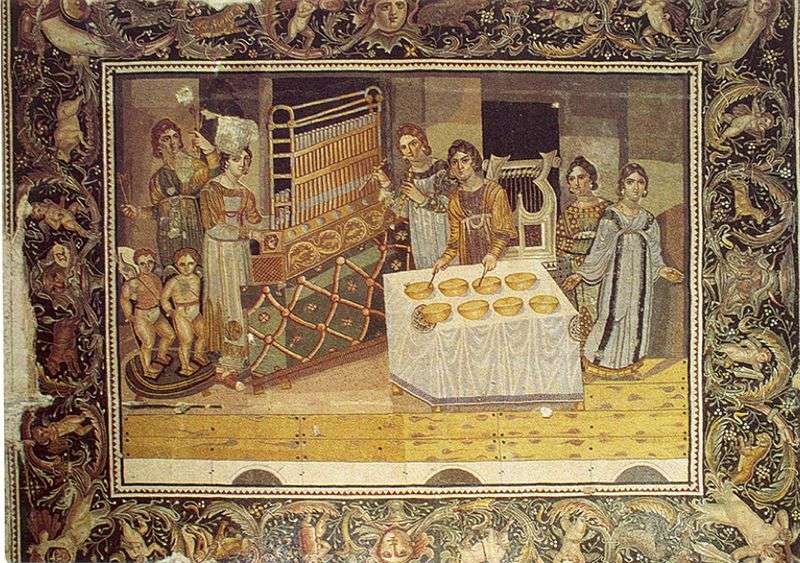
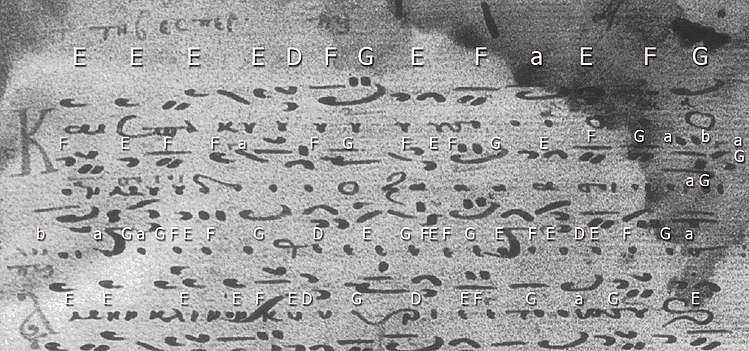
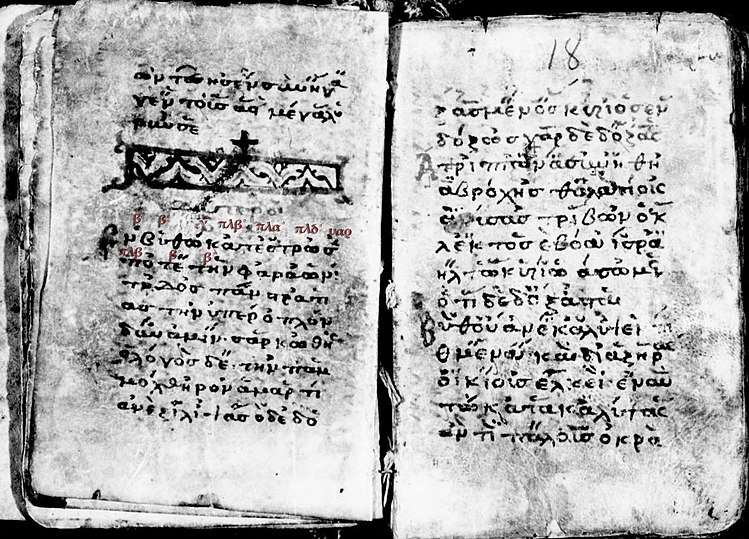
.jpg)